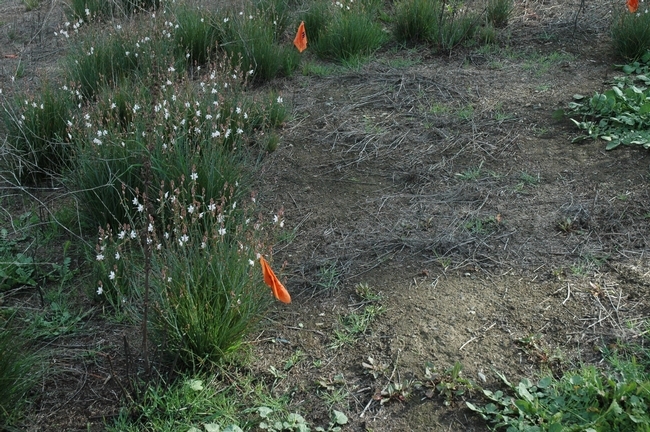Onionweed (Asphodelus fistulosus) is an attractive but very difficult to control weed that is relatively common along highways, some irrigation right of ways and other areas in Southern California. It likely came to our area as an ornamental plant, maybe as part of a seed mix or used (I was told) in reclamation projects in the north county area of San Diego. Once you learn to recognize it, it is easy to spot in spring and summer, especially along interstate 5 from La Jolla and on north at least as far as San Luis Obispo County. Photo 2 is from a restoration site in San Diego County.
In 2005, I started conducting experiments with herbicides for control of onionweed and continued through 2008. I tested seven herbicides at various rates, combinations and times of the year. The herbicides were:
- chlorsulfuron (Telar)
- glyphosate (Roundup, etc.)
- triclopyr (Garlon, etc.)
- imazapyr (Habitat)
- halosulfuron (Sandia)
- rimsulfuron (Matrix)
- dicamba (Banvel)
** If you are interested, you can see all of the onionweed data on my website on the Progress Report webpage. **
Bottom line—chlorsulfuron works (see Photo 4), the others don’t, not even glyphosate at 8 quarts per acre (twice as much as you can legally apply!) And chlorsulfuron only works well at a relatively high rate (2 oz/acre). But in re-reading the 2006 study, I did show that even low rates of chlorsulfuron will greatly reduce seed production. Two herbicides above (halosulfuron and rimsulfuron) are relatives of chlorsulfuron, but do not persist as long in the soil, which would make them better choices for restoration sites, but unfortunately did not work on this weed.
So what do you do if you find it on your property? Get on it right away; try to find out where it is coming from and don’t let any plants produce seed. Each round capsule in the photo on the left will produce 2-3 seed (Photo 6). I counted as many as 30,000 seed per meter square, so this is a very prolific plant species.
It’s an annual or short-lived perennial that does not have vegetative reproductive structures like rhizomes, corms or tubers. Seed are fairly large and according to Weeds of California (click on the link to purchase this book from our UC ANR catalog; this is a publication worth having in your library) persist a long time in the soil, so again, don’t let it produce seed!





